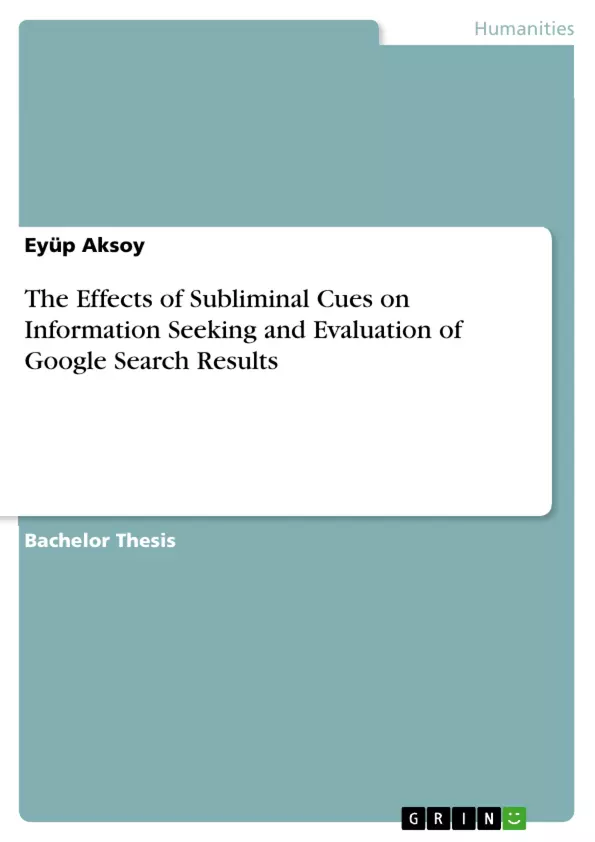In this bachelor thesis, based on the findings by Karremans, Stroebe, and Claus (2006), the effectiveness of subliminal cues on choice behavior was transposed to the online search environment. To give a clear answer for this matter, possibilities but also dangers of online information seeking and subliminal perception have been investigated.
Subliminal stimuli seem to have great potential for this matter since there is much similarity (Strahan, Spencer, and Zanna, 2002) between the factors that make subliminal stimuli effective and the online search environment (i.e. need for information and goal relevance).
An online survey was conducted trying to investigate that goal priming effects subsequent evaluation, but only when certain conditions interact with persons’ attitudes. Half of 98 participants were subliminally primed with the Google ad-icon “Anzeige” and subsequently evaluate on online advertisement and search engines. The results indicated that priming positively influences the evaluation on online advertisement and search engines, regardless of participants’ attitudes towards online search.
Table of Contents
- 1 Introduction
- 1.1 Background on the topic
- 1.2 Purpose of the study
- 2 Theoretical Framework
- 2.1 Subliminal Advertising
- 2.1.1 First Approaches
- 2.1.2 Definition of Subliminal Advertisement
- 2.2 Subliminal Perception
- 2.2.1 Research Background
- 2.2.2 Thresholds perspectives
- 2.2.3 Subliminal Stimuli
- 2.2.4 Introspective Measurements
- 2.2.5 The Masked Prime Paradigm
- 2.2.6 Effects of Subliminal Messages
- 2.3 Information Search
- 2.4 Evaluation on Google Search Result Pages
- 2.5 Hypothesis
- 3 Methodology
- 3.1 Design
- 3.2 Sample
- 3.3 Materials
- 3.4 Procedure
- 3.4.1 Recipient Variables
- 3.4.2 Independent Variable
- 3.4.3 Dependent Variables
- 3.5 Confounding Variables
- 4 Results
- 4.1 Descriptive Statistics
- 4.2 Inferential statistics
- 5 Discussion
- 5.1 Discussion of Results
- 5.2 General Discussion
Objectives and Key Themes
This thesis aims to investigate the effects of subliminal cues on subsequent information seeking and evaluation of Google search results. The study explores the influence of subliminal priming on user behavior within the context of online information retrieval. Key themes of the study include:- The impact of subliminal advertising on information processing
- Subliminal perception and its influence on user decision-making
- The role of subliminal cues in shaping information seeking behavior
- The evaluation of Google search results in the presence of subliminal stimuli
- The potential for subliminal priming to influence online advertising effectiveness
Chapter Summaries
- Chapter 1: Introduction provides the background information about subliminal advertising and its potential impact on information seeking behavior. It outlines the purpose and objectives of the study.
- Chapter 2: Theoretical Framework delves into the concept of subliminal advertising, exploring its historical origins, definition, and theoretical underpinnings. It examines the research on subliminal perception, including thresholds perspectives, stimuli types, measurement techniques, and the masked prime paradigm. The chapter also discusses the processes of information search and evaluation within the context of Google search results.
- Chapter 3: Methodology outlines the research design, sample selection, materials used, and procedures followed in the study. It details the independent and dependent variables, as well as potential confounding factors.
- Chapter 4: Results presents the descriptive and inferential statistical analyses conducted on the collected data. It summarizes the findings regarding the effects of subliminal cues on information seeking and evaluation.
Keywords
The study focuses on the intersection of subliminal advertising, information seeking, and online evaluation. Key concepts explored include subliminal perception, masked prime paradigm, Google search results, information processing, and online advertising effectiveness.- Quote paper
- Eyüp Aksoy (Author), 2015, The Effects of Subliminal Cues on Information Seeking and Evaluation of Google Search Results, Munich, GRIN Verlag, https://www.grin.com/document/306998



